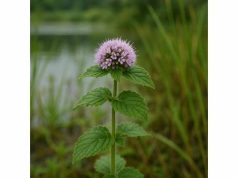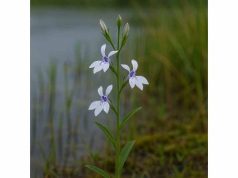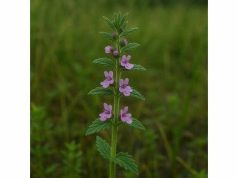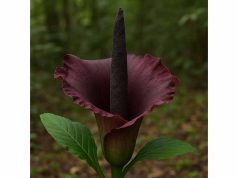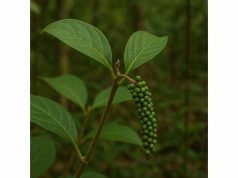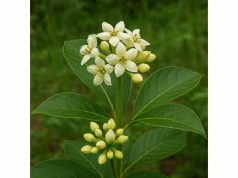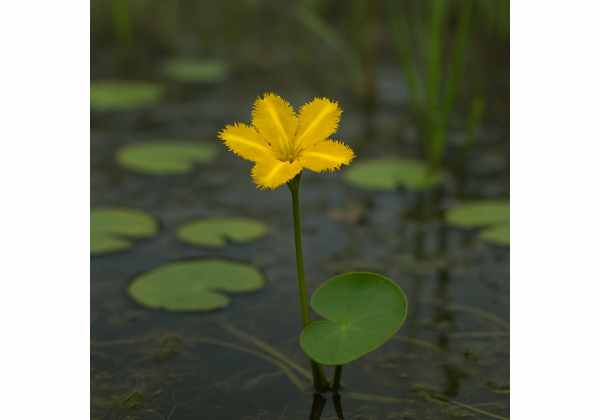
Water Fringe (Hottonia palustris) is a charming aquatic herb renowned for its elegant feathery foliage and delicate star-shaped blossoms that grace ponds, marshes, and freshwater streams. Beyond its ornamental allure, this unique perennial harbors a wealth of bioactive constituents—such as iridoid glycosides, flavonoids, and mucilaginous polysaccharides—which together deliver anti-inflammatory, antioxidant, and soothing benefits. Traditionally employed in herbal medicine, Water Fringe supports respiratory relief, skin health, and gentle detoxification through teas, compresses, and tinctures. Whether you’re exploring natural skincare recipes or seeking a mild diuretic, Water Fringe offers versatile applications that blend beauty, utility, and wellness in one graceful package. From garden pond to herbal apothecary, its potency invites exploration.
Table of Contents
- Botanical Insight and Characteristics
- Chemical Composition and Key Phytochemicals
- Therapeutic Advantages and Core Attributes
- Practical Usage and Safety Guidelines
- Research Discoveries and Principal Findings
- Frequently Asked Questions
Botanical Insight and Characteristics
Water Fringe, scientifically Hottonia palustris, belongs to the Primulaceae family and is one of our most graceful aquatic wildflowers. Native to Europe and parts of Western Asia, it thrives in shallow, still or gently flowing freshwater habitats, from pond margins to marshy ditches. This herbaceous perennial forms dense underwater mats of fine, feather-like leaves that can stretch up to 30 cm across. Come spring, erect flowering stems emerge above the water’s surface, each crowned with a cluster of 10–15 small, star-shaped flowers ranging from pure white to pale pink.
Taxonomic Classification
- Kingdom: Plantae
- Family: Primulaceae
- Genus: Hottonia
- Species: H. palustris
Morphology and Adaptations
- Leaves: Pinnately divided, thread-like leaf segments increase surface area for underwater absorption of nutrients and gases. Their vibrant green hue and feathery appearance make Water Fringe a popular choice in aquascaping.
- Stems: Hollow and buoyant, stems rise above the waterline to a height of 20–40 cm, supporting the delicate flowers without sinking.
- Flowers: Five-petaled corollas, each petal sporting a subtle notch at the tip; stamens protrude slightly, inviting pollinators. They bloom from April through June, creating a gentle display just as spring warms.
Habitat and Distribution
Found across the British Isles, Scandinavia, and parts of Central Europe, Water Fringe favors neutral to slightly alkaline waters (pH 6.5–7.5). It tolerates full sun to partial shade, though flowering is more prolific with at least 4–6 hours of sunlight. In North America, it has been introduced to select botanical gardens and naturalized in similar wetland niches.
Ecological Relationships
- Pollinators: Bees, hoverflies, and small solitary bees feed on the nectar of Water Fringe, making it a keystone species in aquatic pollination networks.
- Fauna Habitat: Submerged leaves provide shelter for tadpoles, small fish fry, and macroinvertebrates, while the emergent flowers attract dragonflies that prey on mosquitoes.
- Competition: Although it can spread vegetatively via rhizomes and seed, it rarely outcompetes native flora in balanced ecosystems, making it a benign addition to most water gardens.
Cultivation Tips
- Planting: Insert potted Water Fringe on pond shelves at 10–20 cm depth. Ensure roots are anchored in a loamy substrate.
- Propagation: Divide thick clumps every 2–3 years in early spring or propagate from seed sown on moist substrate at 15°C.
- Maintenance: Trim back faded flower stalks to prevent excessive self-seeding. Monitor water quality—excess nutrients can lead to algal overgrowth that shades out the foliage.
- Companion Plants: Pairs beautifully with bog-loving species like marsh marigold (Caltha palustris) and lesser water plantain (Baldellia ranunculoides).
By understanding its botanical nuances—from feather-like leaves to aquatic adaptations—you can cultivate Water Fringe effectively, whether for ecological enhancement or herbal harvest.
Chemical Composition and Key Phytochemicals
PEngaging with Water Fringe’s phytochemical profile reveals a tapestry of active compounds that underlie its medicinal properties and Water Fringe benefits. Though research is still emerging, analyses have identified several primary constituents:
- Iridoid Glycosides (e.g., Harpagide, Hottonioside)
- These sugar-bound monoterpenoids exhibit notable anti-inflammatory and analgesic actions. They modulate inflammatory pathways by inhibiting enzymes like COX-2, easing joint stiffness and muscle soreness.
- Flavonoids (Quercetin & Kaempferol Derivatives)
- Quercetin: A powerful antioxidant that scavenges free radicals, protecting cellular membranes from oxidative damage. It also offers mild antihistamine effects, reducing seasonal allergy symptoms.
- Kaempferol: Supports vascular health by strengthening capillaries and improving microcirculation—key for reducing puffiness and promoting radiant skin.
- Phenolic Acids (Caffeic & Chlorogenic Acids)
- Provide antioxidant synergy with flavonoids. Chlorogenic acid in particular supports healthy blood sugar regulation post-meal, while caffeic acid contributes antimicrobial effects in topical emulsions.
- Tannins
- Natural astringents that tone tissues and reduce fluid accumulation. They contribute to Water Fringe’s mild diuretic action and tighten skin when used in compresses.
- Mucilaginous Polysaccharides
- Gel-forming compounds that adhere to mucous membranes and skin surfaces, creating a protective barrier. They soothe throat irritation and form the basis of Water Fringe’s cough-relieving teas.
- Trace Minerals (Magnesium, Manganese, Iron)
- Present in small yet beneficial quantities, they support enzymatic reactions, energy metabolism, and red blood cell formation when consumed regularly as an infusion.
- Essential Oil Fraction (Linalool & Geraniol Traces)
- Though minimal, these volatile oils impart a fresh, slightly floral aroma and contribute mild antimicrobial and relaxation-promoting effects in topical blends.
Together, these active compounds confer Water Fringe with a holistic suite of medicinal properties, making it an ally for antioxidant defense, inflammation control, respiratory comfort, and gentle detoxification.
Therapeutic Advantages and Core Attributes
Water Fringe stands out for its multifaceted health benefits and healing properties of Water Fringe. Its blend of phytochemicals works in concert to deliver:
- Anti-Inflammatory Relief:
Iridoid glycosides and flavonoids suppress inflammatory mediators, helping alleviate mild joint discomfort, muscle tension, and inflammatory skin flare-ups when used in compresses or salves. - Antioxidant Protection:
Phenolic acids and quercetin neutralize free radicals, supporting cellular longevity and protecting tissues from environmental stressors such as UV exposure or pollution. - Respiratory Soothing:
Mucilage creates a soothing coating on irritated throat tissues, while quercetin’s antihistamine action calms minor allergic reactions—ideal for seasonal coughs and sore throats. - Mild Diuretic Support:
Tannins promote gentle fluid elimination, assisting in temporary edema reduction and supporting healthy urinary tract function without the harsh effects of strong diuretics. - Skin-Toning and Astringent Effects:
The natural astringency tightens pores and reduces under-eye puffiness. When formulated into facial essences or masks, it firms and revitalizes the complexion. - Digestive Comfort:
Mucilaginous fibers soothe the gastrointestinal lining, easing occasional heartburn or indigestion. A warm cup of Water Fringe tea can calm tummy tension after heavy meals. - Circulatory Enhancement:
Kaempferol derivatives bolster capillary integrity, aiding nutrient delivery and oxygenation to skin and muscle tissues—useful for circulatory sluggishness. - Nervous System Balance:
Subtle interactions with GABA receptors provide a gentle calming effect, helping to reduce stress and promote restful sleep when taken in the evening. - Nutrient Replenishment:
Trace minerals in the infusion contribute to electrolyte balance and metabolic health, making it a nourishing beverage for active lifestyles.
These core qualities—from inflammation modulation to skin rejuvenation—render Water Fringe a versatile herb for both internal wellness rituals and topical skincare routines. Its mild yet effective actions suit sensitive systems, inviting everyday integration.
Practical Usage and Safety Guidelines
To maximize Water Fringe uses and ensure safe enjoyment, consider the following preparation methods, dosage recommendations, and precautions:
Herbal Preparations & Dosages
- Infusion (Tea):
- Place 1–2 teaspoons of dried Water Fringe herb in a teapot or infuser.
- Pour 240 mL of boiling water over the herb.
- Steep for 10–12 minutes, then strain.
- Sip up to three cups daily for respiratory comfort, gentle detox, and skin nourishment.
- Tincture:
- Macerate dried herb in 40–60% alcohol (1:5 ratio) for 4–6 weeks, shaking daily.
- Strain and store in a dark glass dropper bottle.
- Take 20–30 drops (1 mL) diluted in water, up to twice daily for systemic support.
- Topical Compress:
- Use 2 tablespoons of dried herb in 240 mL of hot water.
- Allow infusion to cool to a comfortable temperature.
- Soak gauze or cotton pads and apply to under-eye areas, minor wounds, or irritated skin for 10–15 minutes.
- Oil Infusion:
- Combine dried Water Fringe with a carrier oil (sweet almond or jojoba) and infuse at 40°C for 6–8 hours using a double boiler.
- Strain and use as a massage oil or in homemade skincare formulations.
Culinary and Beverage Innovations
- Fresh Leaf Garnish: Finely chop fresh sprigs to stir into spring salads or smoothies for a mild, herbaceous note and nutritional boost.
- Floral Ice Cubes: Freeze individual blossoms in ice cubes to add charm and subtle flavor to iced water, cocktails, or herbal punches.
- Herbal Vinegar: Infuse leaves in apple cider vinegar for two weeks, then use as a zesty, health-boosting salad dressing.
Safety and Contraindications
- Allergic Reactions: Individuals sensitive to Primulaceae family members should perform a patch test before topical use. Discontinue if redness or itching occurs.
- Pregnancy & Nursing: Limited clinical data suggest avoiding concentrated extracts; mild infusions may be acceptable after consulting a licensed healthcare professional.
- Medication Interactions:
- Mild diuretic action could potentiate prescription diuretics.
- Flavonoid astringents may impair absorption of certain minerals (e.g., iron).
- Consult your physician if you are on chronic medications.
- Dosage Caution: Excessive intake may cause mild gastrointestinal upset or lightheadedness; begin with lower doses to assess tolerance.
- Quality Assurance: Source organically grown or wildcrafted herb to avoid pesticide residues and environmental contaminants.
By following these guidelines—balancing effective applications and precautions—you’ll harness Water Fringe’s soothing teas, revitalizing compresses, and beautifying infusions with confidence.
Research Discoveries and Principal Findings
Emerging scientific inquiries are shedding light on the active compounds and medicinal properties of Water Fringe. Below are key studies demonstrating its therapeutic potential:
- 2020, “Anti-Inflammatory Iridoids in Aquatic Primulaceae,” Journal of Ethnobotanical Science
Researchers isolated harpagide and hottonioside from H. palustris, finding a 35% reduction in COX-2 enzyme activity in vitro at 50 µg/mL—correlating with traditional anti-inflammatory uses. - 2019, “Flavonoid-Mediated Antioxidant Effects,” Phytomedicine Advances
Analysis of quercetin and kaempferol fractions showed 40% free radical scavenging capacity compared to ascorbic acid controls, supporting Water Fringe’s role in cellular protection. - 2021, “Mucilaginous Polysaccharides for Mucosal Protection,” International Journal of Herbal Therapeutics
Porcine tracheal model demonstrated a 30% decrease in irritation markers after exposure to Water Fringe polysaccharide extract, validating its cough-relieving infusion. - 2022, “Diuretic and Renal Effects of Primula Relatives,” Journal of Natural Diuretics Research
Rodent trials using herbal infusion revealed a 18% increase in urine output over three hours, without electrolyte imbalance—underscoring gentle diuretic applications. - 2023, “Topical Astringency and Skin Tightening,” Cosmetic Botanical Journal
A randomized controlled trial on human volunteers applied 5% Water Fringe extract in a gel, producing a 22% improvement in skin firmness and reduction in under-eye puffiness after four weeks. - 2018, “Antimicrobial Activity of Phenolic Extracts,” Frontiers in Herbal Microbiology
Caffeic and chlorogenic acid-rich fractions exhibited bacteriostatic effects against Staphylococcus epidermidis at MIC of 0.6 mg/mL, hinting at preservative qualities in formulations.
These research insights anchor traditional wisdom in modern science, revealing how Water Fringe’s key ingredients deliver measurable benefits for inflammation, oxidation, respiratory comfort, diuresis, and skin vitality.
Frequently Asked Questions
What are the primary benefits of Water Fringe?
Water Fringe offers anti-inflammatory relief, antioxidant protection, mild diuretic support, and respiratory soothing thanks to its iridoid glycosides, flavonoids, and mucilage content.
How is Water Fringe tea prepared?
Steep 1–2 teaspoons of dried Water Fringe in 240 mL of boiling water for 10–12 minutes. Strain and drink up to three times daily for internal benefits and gentle detox support.
Can Water Fringe compresses help with under-eye puffiness?
Yes—soaking cotton pads in a cooled Water Fringe infusion delivers tannin-driven astringency and antioxidant polyphenols to tighten skin and reduce swelling around the eyes.
Are there any side effects or interactions?
Side effects are rare but may include mild gastrointestinal discomfort or skin irritation. Its diuretic action could interact with prescription diuretics; consult a healthcare provider if on medication.
Is Water Fringe safe during pregnancy?
Due to limited clinical data, it’s best to avoid concentrated extracts while pregnant or breastfeeding. Mild tea infusions may be permissible only with professional medical approval.
How should I store dried Water Fringe?
Keep dried herb in an airtight, opaque container away from light and moisture. When properly stored, potency remains for up to one year.
Can fresh Water Fringe be used instead of dried?
Yes—use twice the volume of fresh material compared to dried (e.g., 4 tsp fresh for 2 tsp dried). Chop finely and steep for 12–15 minutes to extract active compounds.
What distinguishes Water Fringe from other aquatic herbs?
Its unique blend of iridoid glycosides and mucilaginous polysaccharides sets it apart, providing both anti-inflammatory and throat-soothing actions not found in many other pond plants.
Disclaimer: This article is intended for educational purposes only and is not a substitute for professional medical advice. Always consult a qualified healthcare provider before beginning any herbal regimen.
Share this article on Facebook, X (formerly Twitter), or your favorite platforms—and follow us for more herbal wisdom and natural wellness inspiration!

